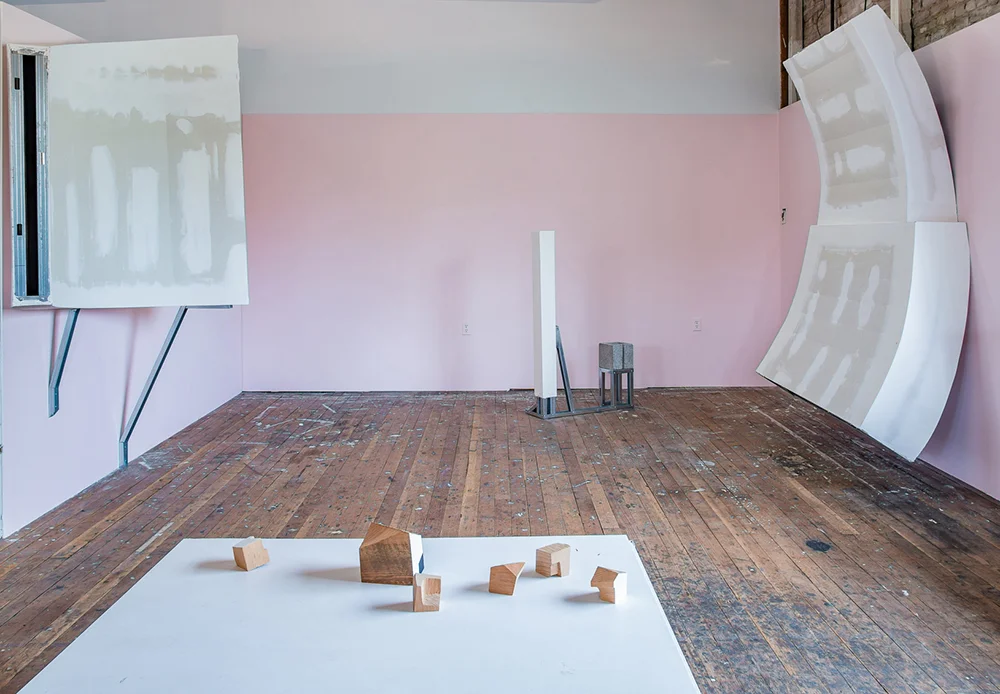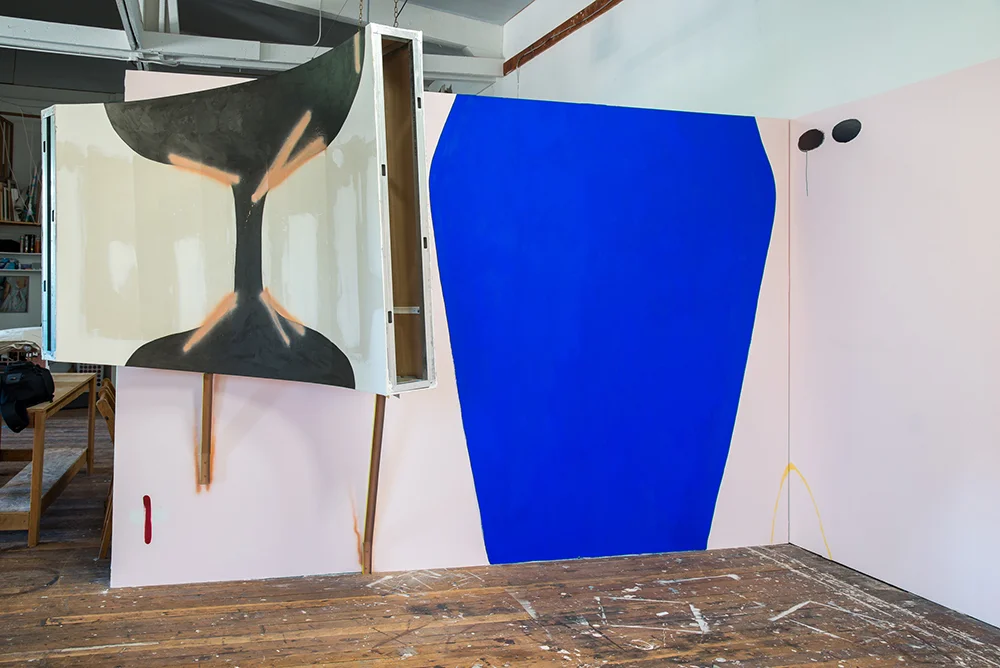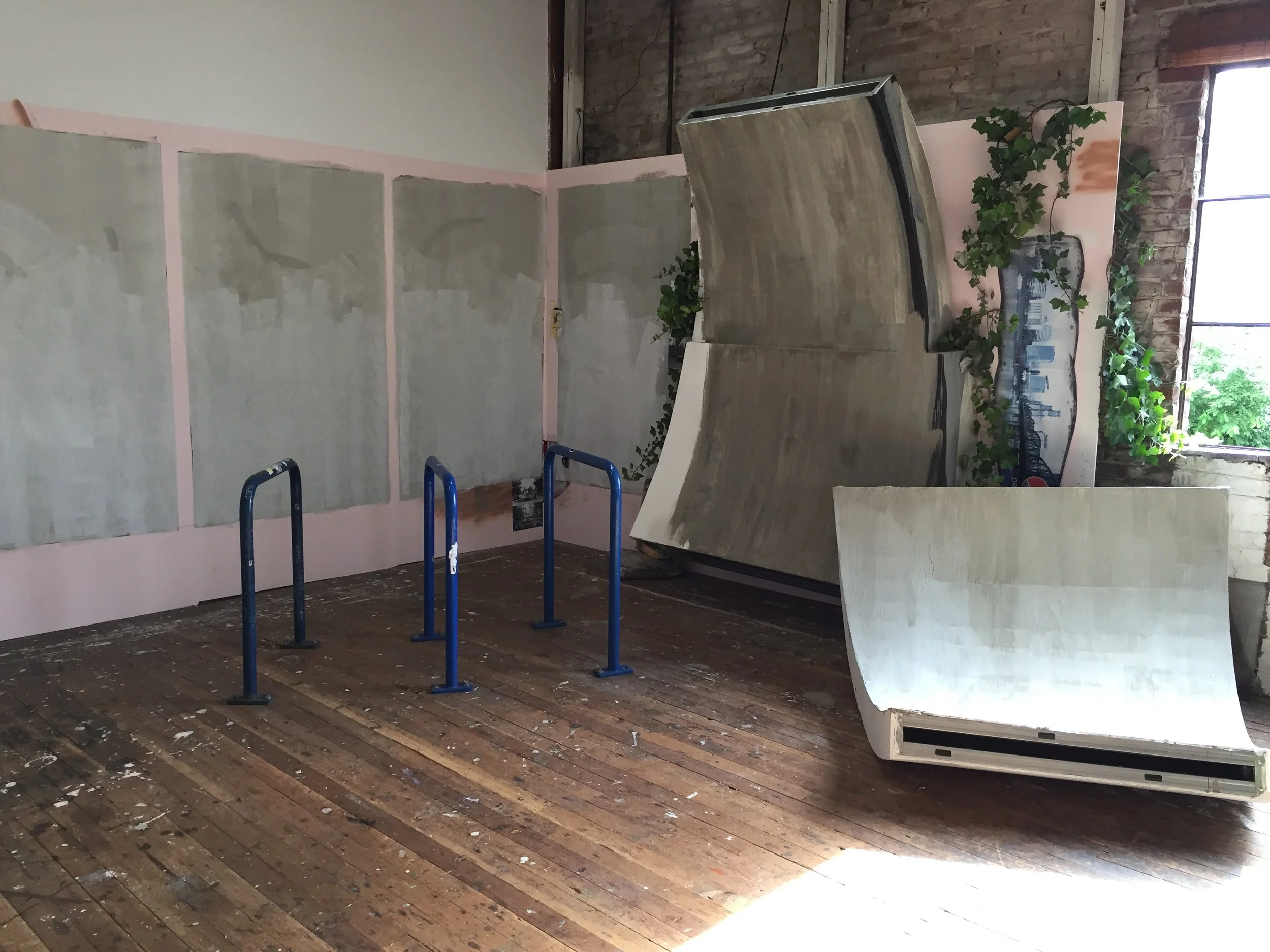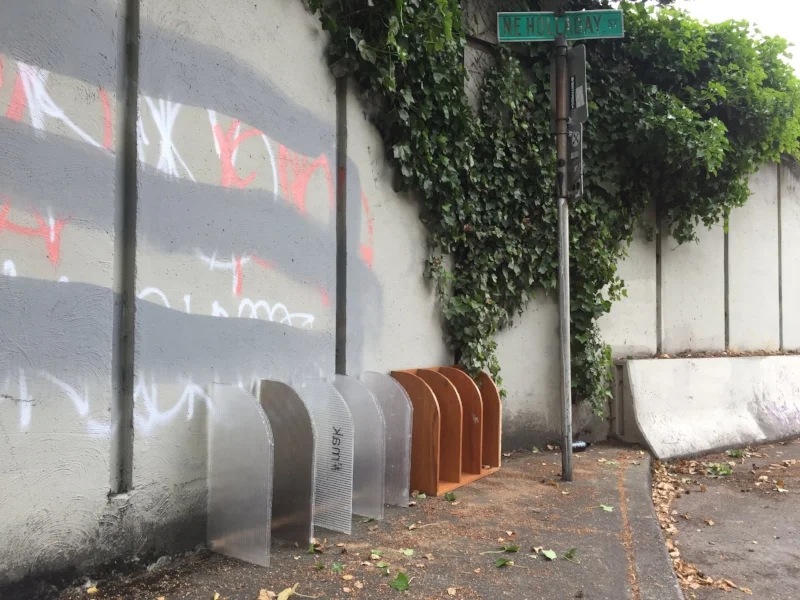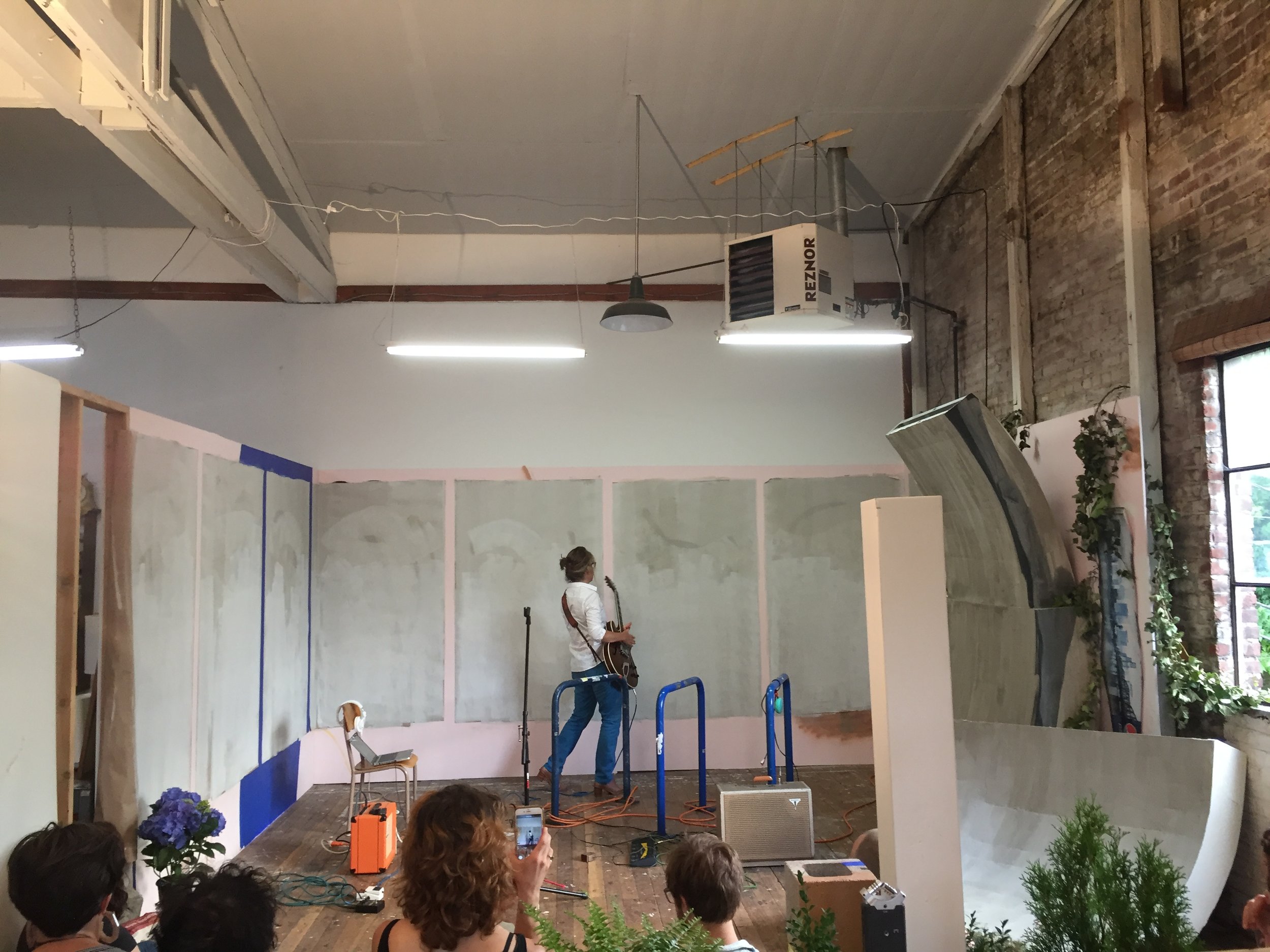(re)buffer at Private Places
The programming of (re)buffer, recently on view at Private Places from April 22- June 22, is a theatrical and ambitious rendition of traditional gallery exhibitions. Split into three “acts” with an “intermission”, (re)buffer is durational and builds on itself much in the same way that one might expect of a staged performance. Private Places retains an air of mystery in the descriptions of the acts; the artist names are reduced to initials, color and architecture play in the role of the characters, and the dramatic unveiling of the actual scene is reserved for opening nights. The title (re) buffer is meant here as both action and reaction, one in which “continuance obliges provocation - an incitement to engage.” As one act is played out, it begs a subsequent response from the following entity, asking to create a conversation around the manipulation of space and place. No act is final and no act negates its prior.
The coy nature of this programming mimics the coy nature of Private Places as well. The industrial gallery space located in NE Portland doubles as the studio of local artist and founder, Bobbi Woods. The name of the gallery is as serious as it is joking -- it takes the intimate space of a working studio and expands its role of production onto a larger scale, making it open to outside voices. Thus, the concept of (re)buffer was conceived with the help of friend, Karl Burkheimer, as a response to these spatial parameters, to the potential creative limitations they incite and as a result, it in turn asks of its artists to do the very same. The act of (re)buffer-ing, although seen here only in four phases, ultimately has the potential to keep reiterating infinitely.
The curtain opens onto act one in which Karl Burkheimer is the first artist to further entangle the notions of property and ownership. He primes the stage and sets off a chain of reactionary responses from each of the subsequent artist-actors. Working from a somewhat blank slate, still responds to the existing parameters imposed by the gallery itself by building the three exposed drywall structures that populate the stage. Reminiscent of Brut, exposed architecture these sculptures offer the foundational support for the program -- each subsequent act incorporates and reinterprets them in their own fashion. Burkheimer’s act is clean and simple; the potential for an inventive story is palpable. The walls are painted a smooth, pale pink; two of the curved structures hang sturdily on opposite walls, left raw; and the third drywall sculpture, a tall and skinny rectangle supported by a metal beam and a cinder block, lives to the right of the space. On a low table across the stage are small, wooden shapes carved geometrically, left bare, also on display. This grouping of four raw elements are cohesive in their tenderness; this is the opening scene.
Fading away from the liminal space where Karl Burkheimer’s work hovers, we transition into act two directed by painter Amy Bernstein. The rising action is steadily building upwards and like Burkheimer, Bernstein also avoids specific figural representation, but in a drastically different arrangement. Here, she reinterprets not only the act that has come before her but also her own stylistic approach to painting. At Private Places she is prompted to expand off of the limitations imposed by a canvas medium and carry out her themes onto the space directly. Bernstein adds color as a protagonist, carrying out bold lines and movements on the structures, the cinderblock, and most prominently the walls. The left wall of the space is painted almost entirely an electric blue, vaguely reminiscent of a large portal through which other players can enter and exit. Incorporating every nook and cranny, each facet of the gallery down to the piping and electrical wiring of the building, Bernstein’s ability to transform the mundane into a dreamscape of color and organic shapes in this immersive manner is striking. Where Burkheimer is a clean and calculated slate, Bernstein’s attention to minutiae, down to the two tiny red pins placed on adjacent corners of the painted cinder block, executes its own specific order and command of the space.
The light dims and intermission comes. Los Angeles based artist Chris Lipomi arrives a stranger on the stage to provide a respite. However, Lipomi’s “A Loc is Pep” is extensive, a reimagining of both acts one and two, and the city of Portland as well, making his “intermission” more of a transformative intervention. Borrowing from his surroundings, this installation is less “private” than the others in that it incorporates elements from the world immediately outside the gallery space. A giant cutout of a cola bottle with the Portland skyline is wheat-pasted onto one of the gallery walls after being “borrowed” from the nearby soda plant. The title itself has been borrowed, “A Loc is Pep” being Pepsi-Cola written backwards. Other wheat pastings also cover the gallery showing before and after photos of the over-development of the city, demonstrating the rapid growth that has and is taking place in our current environment. Three bike racks, in the same bold blue as Amy’s paint, have been repurposed and feature prominently in the center of the space. Lipomi has removed the cement structure that previously occupied the left wall and placed it to the right, on the floor below the other sculpture mimicking a more free-moving trajectory through the space. Incorporating his own background of skateboarding and street art culture, the two structures now resemble a shambly but still recognizable half of a halfpipe that directs viewer’s gaze back into the space and also out through the window onto the street.
Following this gaze, the show spills out onto Holladay Street where Lipomi has further enmeshed internal and external, installing his own rendition of a piece of wooden shelving that has been abandoned on the side of the road right alongside the original. In the spirit of rebuffering, Lipomi makes do with his immediate surroundings, pulling in elements from the space, the artists before him, and the outdoors, and in doing so he tells me “shoot for mediocrity, banality our saviour!” However, being the only artists out of the four to directly address the drastic problematics of the city’s rapid industrialization, while not being a current resident of Portland, lends a misplaced, albeit very relevant, weight to his installation.
The final act of this narrative culminates in a moment of sensational release and shifts rapidly into the denouement. With “cord shapes“, Rebecca Gates is the first of the four artists to bring actual performance into this theatrical feat. A sound study and sonic interaction with the space, Gates has set the stage amidst Lipomi’s installations. Act three is imbued with a sense of urgency as the need for resolution begins to be felt. Both the climax and the exiting, Gates fuses elements of Lipomi’s work with her own phonic experience, her cords and pedals weaving effortlessly throughout the prior scene, and this final act manifests itself in a singular, all-encompassing performative gesture. More experiential tangible, the transience of this cinematic finale conflates privacy and ownership in that it is meant to be witnessed in the specific setting of PP and not to be recreated. As she concludes her set, the audience applauds and the light dims a final time. The production comes to a draw.
Private Places first opened with more traditional programming in mind, showing artists on a monthly rotating basis. Woods reconsidered this approach after noticing that the physical U-shape of the gallery could also read as a stage around which viewers gather. While four acts spread out over three months may appear too long to ask for one’s engagement, the originality of this tactic leaves audience members waiting to see what will come next. Much like the draw of anticipation and expectation, the inherent interconnectedness of each act has viewers returning to see the developments made to the characters and the set. Is act four already at play, hinting at a future restaging initiated by the us, the spectators, leaving the space? The success of this specific structuring of a prolonged exhibition lies in its continued ability to excite and provoke gallery-goers. In manipulating the same props to arrange different themes by virtue of different executions, the spectacle at show is wildly reconfigured each time, utterly unpredictable and continually surprising.
Images courtesy of Private Places. Visit Privateplaces.us for more.

